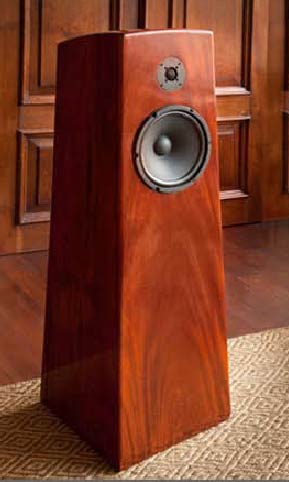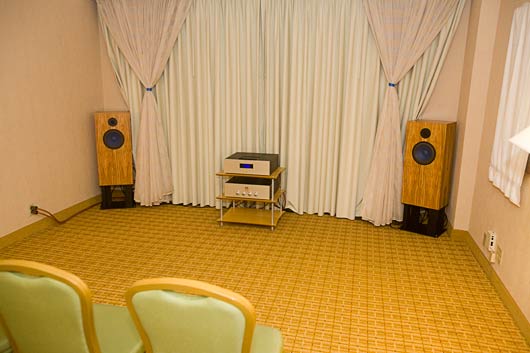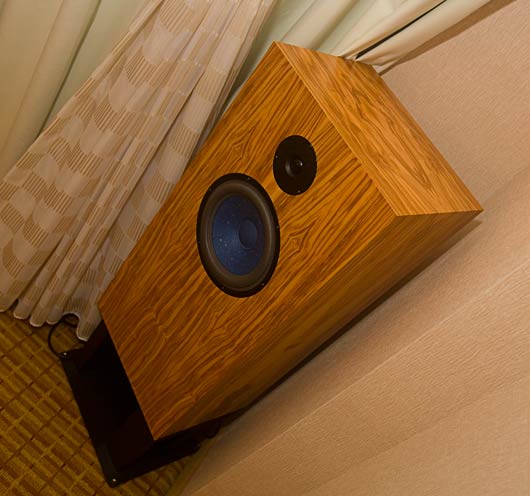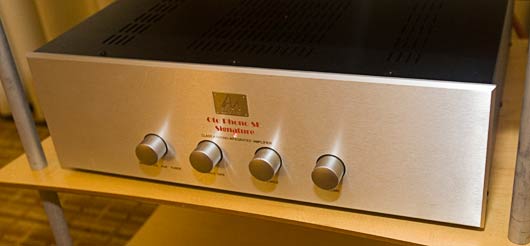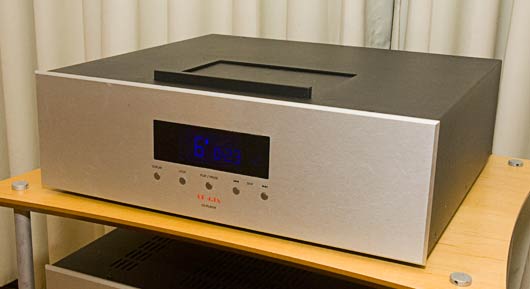Unfortunately, our room never did get to where we wanted it this year. It wasn’t because a piece or two of equipment was brand new or anything, it was because we just didn’t get it setup optimally in the 4-days we were adjusting and adjusting and adjusting it.
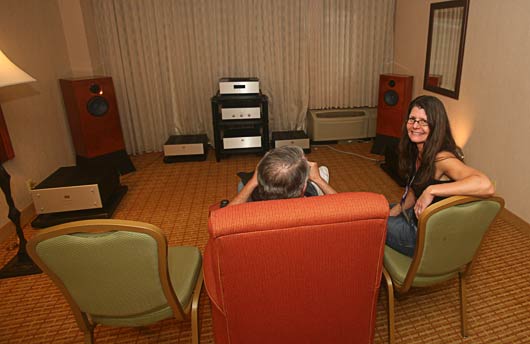
Neli early afternoon Sunday, the last day of the show
AN/E SEC Signature speakers
Kegon Balanced monoblock amps
M9 Phono preamplifier
Fifth Element DAC and Fifth Force power supply
CDT-5 transport
SOTTO and PALLAS cabling
Sogon power cords
When we picked the room, we were fully intending on showing a system like last year: The new Marten Coltrane 2 speakers, The Audio Note Ongaku integrated amp, Nordost ODIN cables, and the Emm Labs XDS1 CD/SACD player.
But we had shown Marten 5 of the last 6 shows, Nordost 6 of the last 6, and Emm Labs also 5 of the last 6, I believe. Over the course of the year, we decided to show the Audio Note speakers instead (last time we showed them it was in our large suite that we used to have at these shows). Which soon became a 100% AN system. And, somehow, we [or at least I] thought that the room we had picked had real corners, so that the speakers would really work the way it is supposed to. Corners do not matter for the Marten speaker but they really do for the Audio Note [much more later]. I know we did discuss which rooms had corners and which had air conditioners and conduits in the corners – and for some reason I thought only rooms that faced the atrium had air conditioners and well, wishful thinking I guess.
Oh well.
Oh, and before I forget – the small rooms in the tower are better than the small rooms on floors 4 and 5. They appear to have more solid walls, to be slightly larger, and the carpet is thicker, the hallways wider and the carpet thicker out there as well. In other words, they are more isolated from external noises – aka other exhibit rooms – than the rooms on floors 4 and 5. So maybe next year, if we show again at RMAF, we will get a tower room.
Anyway the next 4 days became an object lesson about how small movements of a speaker affect the sound of AN speakers [usually we move the speakers AND adjust the cabling and power cords to get the sound to where we want, but we wanted to keep this a 100% Audio Note system. We all setup little goals in life and this was ours last week].
We set the speakers equidistant from the sweet spot and at 45 degree angles to the corners – such as they were – a foot or so behind the speakers – to optimize bass response and listened. It was a little hard and bright on some passages so we toed them in a few times ending at about a 1/2 inch more toed in and we got highres, emotional, tuneful music. The reason for the large toe-in is that Audio Note speakers are designed to sit right smack tight in the corners, horn-loading the corner and using the corner itself as part of the speaker to increase bass response and room engagement [and other frequencies as well, like a megaphone or cupping your hands in front of your mouth like a little horn to increase the SPL of your voice].
This was pretty much the setup the first day.
Problem was that, although there was lots of bass during passages that had bass, the overall presentation was somewhat lean. The midrange was not getting that ‘full’ sound that comes with having bass even when bass notes are not being played. We were just too far from the corners.
So that night [or the morning the next day – hard to remember, except that we did it when no people were there to see us huffing and puffing with these little speakers :-)], we tried moving one speaker, the left side, which was about an inch or two from the sidewall, to sit directly against the wall – to get a fuller sound.
Hmmm…. now the left side was noticeably louder than the right – not just in the bass, but just about all frequencies were louder. The corner it was sitting in was a less deformed corner than the right side’s corner.
So we decide to bring them forward some to get them away from the corners so that the left side would see a corner more like the right side, so both sides would have somewhat similar freq responses to each other. And somewhere in here Neli mentions that Peter Qvortrup, of Audio Note, had suggested we move the speakers forward some. You know, sometimes spouses are the slightest bit annoying. So we go back and forth about how much to move them forward, and Neli decides from one boldish yellowish strip to the next, or about 4 inches [everything on these carpets is easy aligned by watching where the stripes are. VERY convenient]. Me, I do not care how much forward we move them, I think we just need to move them and see if it gets better or worse and in what manner it does this.
After the move it sounds like the SPL have actually increased [even though it is further from the corner], and the speakers are back to performing their usual disappearing act.
But we still weren’t getting as much of that ‘full sound’ as we were hoping for.
Now for a slight digression.
Something has to go between the speakers and the speaker stand. We often use HRS Nimbus Couplers, flexible custom polymer ‘cookies’ that are made to channel vibrations between 2 solid objects. This allows us to 1) easily adjust the orientation of the speaker [a towel between speaker and stand works wonders here too] and 2) optimize the amount of observed resolution at the listening positions. Both Audio Note and HRS do not really recommend this [AN thinks it is detrimental and HRS thinks it is unpredictable – depending on the speaker design characteristics]. But hey, at least some of us Americans are still bad at following rules and like to think for ourselves, experimenting with all sorts of stuff [and not just the economy :-)] to see just what happens.
So, kind of in that spirit, and because we were kind of desperate, we decided to try following the recommended procedure in this case and use Blu Tak [kind of like blue Silly Putty, or clay] between the speaker and speaker stand.
Definitely different.
Essentially more dynamic, more immediacy and more PRaT. More exciting.
There was also, as expected, less resolution [Peter Qvortrup thinks there is just less energy in that region of the frequency band, that the frequency response is now more flat, more linear, more accurate.] Maybe PQ is right, but we like our resolution, helps prevent a hardness in the sound – especially during notes like an opera singer belting out a high note, or a guitar player smacking a high note – very high resolution helps break up those notes from being a solid hammer on the ear drum to become multiple shades of harmonics that the ear can process comfortably, in fact even pleasurably 🙂
OK. So we put HRS Nimbus under the preamp and DAC power supplies [we did not have enough on the first day to do this] and we adjust the speakers toe in again and again – trying to get the resolution as high as possible. We KNOW it is there right? We know it is getting to the speakers and we know the speakers can reproduce it. We are still orienting the speakers around the 45 degree angle, pointing somewhat directly away from the corners of the room, such as they are. We are only partially successful at this but overall the sound is better after these changes and we leave it in this configuration on Saturday and most of Sunday.
Well, Sunday was slow. Sunday mornings are always slow. And it doesn’t get that much better later, peaking around noon or 1 pm (the show closes at 4pm). Not so much because of people going to church but because of Football [esp. if the Broncos are playing] . At least, that’s what I think, living here outside Denver for several decades now.
So, eventually, we get bored.
Earlier Sunday morning Neli and Peter were having coffee and I was watching them drink it [I’m not a coffee drinker, though I love the aroma] and we were all talking and he sketched out a diagram showing how orienting the speakers differently can take advantage of the 1st reflections off of the side walls to augment the perceived SPL of the midrange frequencies. [we have not seen this in the manual or on the websites, and will write this up in a different post so it is more easily Googleable]. The basic idea is that if the sound from the 1st points of reflection arrive no later than 2.7ms (or 3.2ms – not sure here) then the ear will not be able to detect a difference between the two. In this way the speaker will appear to be more powerful than it really is.
Cool huh?
So I manhandle the speakers on the Blu Tak, without moving the speaker stands, so that they no longer cross in front of the sweet spot and in fact look like more normal positions. The 4 corners of the speakers are kind of hanging off the stands and I am not sure all the blutak is in place – but we only have an hour or two left to the show and visitors come in and leave quickly, not really listening, as they approach warp speed trying to see everything they did not get to in the previous 2.5 days.
I hadn’t talked to Neli about this first, and was hunkered down for the possible sh*t storm for seriously mucking with things in the middle of a show day – but she was apparently preoccupied with those business-like tasks that make it so we can eat next week – because I am still alive to tell the tale and able to write this report … 🙂
After this adjustment of the speaker orientation, the midrange frequencies were indeed boosted some, the SPLs increased yet again, and we did get an increase in resolution. The sweet spot no longer worked, however, being now either too close to the front of the room or something because the speakers no longer disappeared from that position. ‘Course the speakers were not exactly symmetrical 🙂 and, whatever, the show was over and we were tired and it was time to go home.
——————–
Every room is different, but I personally like to have a number of arrows in my quiver that have some kind of predictable behavior, so that if we run in a problem, say X, we know that we can try A, B and C to try to ameliorate the problem.
Not only that but I like to understand in what circumstances the darn arrows work, and do not work, to the point of being able to describe them to other people [do you know how RARE this is? to actually understand something well enough to describe it? Schools these days just teach people by rote, to follow little rules blindly]. And, finally, to document them, so that other people can use them too. Can’t but imagine this would be useful to other people besides us.
To that end we will try and setup a Toolbox category here on the blog, or on the website, where we document how to go from sound point A to sound point B [there will no doubt be many ways, some expensive, some free (yes, you might want to try the free ones first)] and not just with respect to Audio Note and Audio Note speakers, but cabling and vibration control and all the rest.
